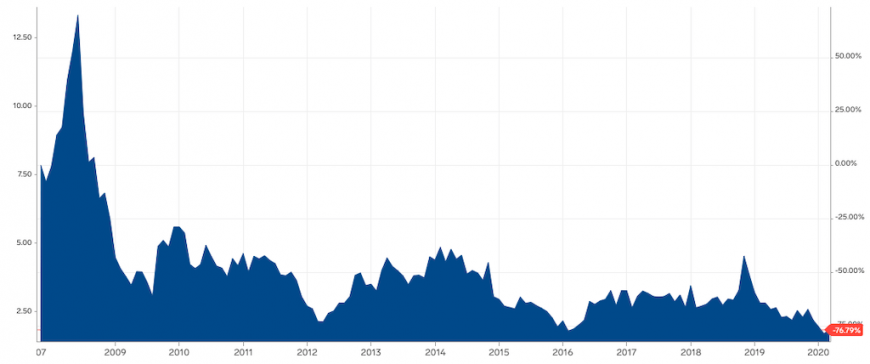
Natural gas is one of the most commonly used non-renewable hydrocarbons. Its price influences almost every household, directly or indirectly.
As almost every non-renewable energy source, it releases carbon dioxide when burned. Therefore, one of the biggest influencing factors of natural gas prices is green energy – or renewable energy (like solar power, wind power, etc.)
But what are the other important price-influencing factors, how will the gas prices change in the near future (2020-2021) and what is our long term natural gas price forecast (next 5 years)?
Price of natural gas outlook
We measure the gas in units of MMBTU, which is one million British Thermal Units – in short: BTU. BTU is the energy content in fuel, which is used in power and steam generation. One BTU is equivalent to 1.06 Joules.
In 2019, natural gas production grew by almost 10 billion cubic feet per day (Bcf/d), 10% increase compared to the previous year (2018). It was the highest volume on record – according to the U.S. Energy Information Administration’s (EIA). Probably, the trend will not continue in 2020.
There are 3 main reasons:
- Winter was warm, so gas storages are not empty
- Saudi Arabia – Russia price war
- Coronavirus


Demand has continued to fall in Europe and the U.S. as well, because travel is restricted and daily life grinds to a halt, pushing oil prices lower.
The virus will dictate the natural gas prices in the next 6 months (minimum) – that is for sure. The question is: For how long?
Natural gas prices forecast
We are at the lowest price ever (Henry Hub prices).

The low price means savings for home owners and drivers – but benefits will fade away by the economic costs of both the viral outbreak and the collapse of gas prices.
The EIA’s short-term energy outlook suggests that natural gas prices at Henry Hub will average $2.33 per MMBtu in 2020. This will be $2.54 per MMBtu in 2021, according to EIA. But recently, AAA spokeswoman Jeanette Casselano said: "Should trends continue the way they are, there's a possibility we could see the national average hit $2 in the next coming weeks (in the U.S.)".
The Saudi-Russia price war hurts the oil companies not just in the U.S., but all around the world.
Our gas price projection is that the low natural gas price forecast for 2020 is expected to make natural gas production decrease, creating an upward price pressure in 2021, limited by contracting demand.
But what is the natural gas price forecast in the long term?
Natural gas price predictions for the next 5 years
The first and most important question is when will natural gas prices go up.
In 2024, IMF forecasts that the Henry Hub price will increase to $2.65 per MMBtu. Meanwhile the World Bank gives a more optimistic projection: $3.16 per MMBtu. World Bank expects that the natural gas price at Henry Hub will increase to $4 per MMBtu by 2030.
Conclusion
There are 3 short-term and 1 long-term factors influencing gas prices strongly. The short-term factors are:
- Weather
- Saudi Arabia–Russia price war
- Coronavirus
The natural gas price forecast for the next six months is absolutely dependent on the coronavirus and how widely it spreads. The longer it takes, the worse it gets.
The biggest long-term factor is renewable energy, such as solar or wind power.
We have the lowest prices (Henry Hub prices), which is good for some people, but if you look at it globally and economically, it will be really bad for most people.
We do not know yet how the coronavirus and the price war will affect natural gas prices, because there is no recession now – but everything is frozen, which is worse.
